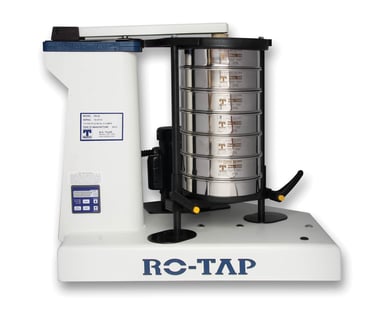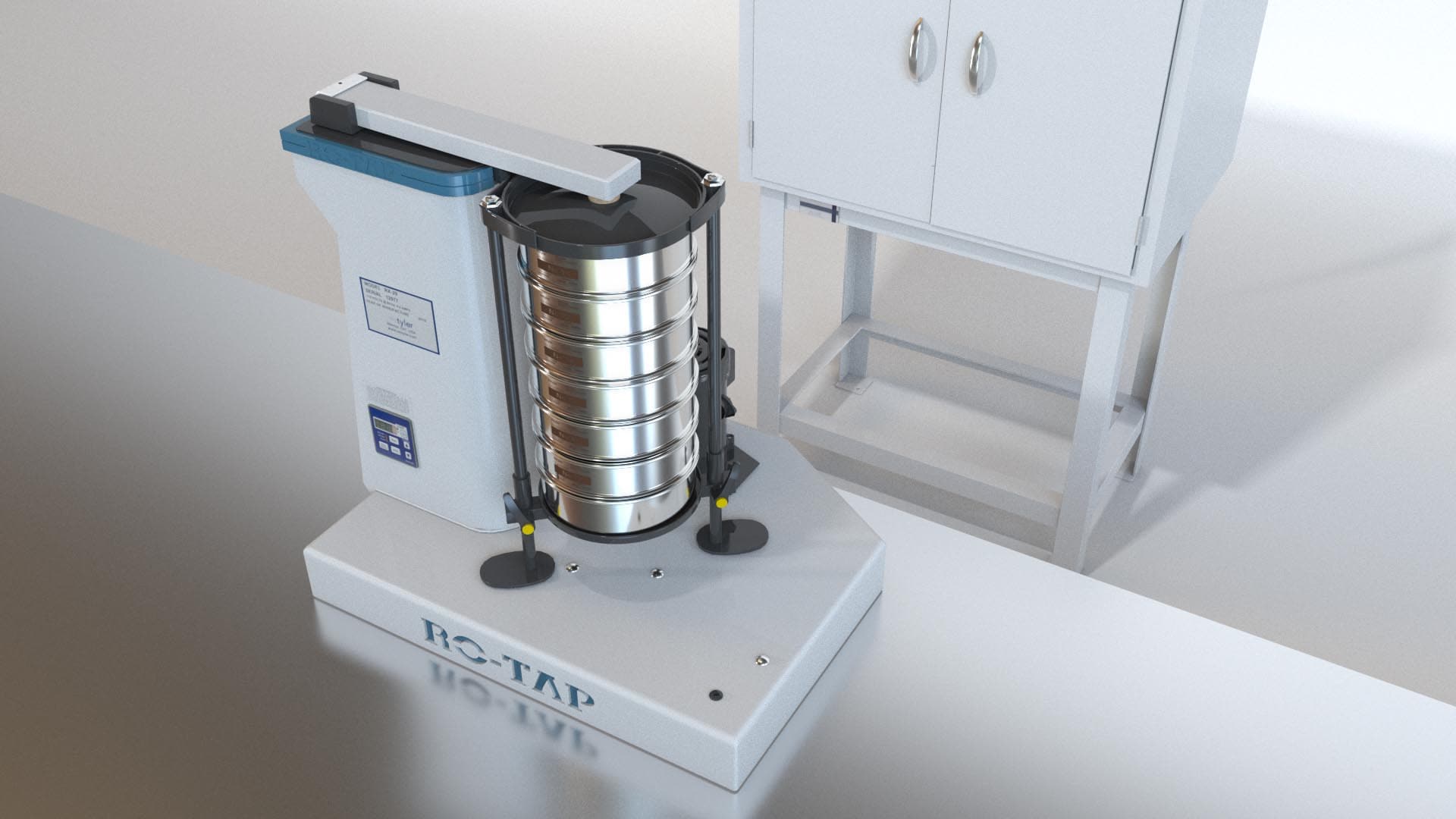W.S. Tyler RO-TAP® RX-29 vs RO-TAP RX-94
For centuries, test sieve analysis has been the gold standard in terms of producing accurate and repeatable particle size analysis results. While devices like electromagnetic sieve shakers have become more widely used in recent years, mechanical sieve shakers have been the prominent devices to use.
Now, odds are you have heard of the W.S. Tyler RO-TAP® RX-29 as it has been a premiere mechanical sieve shaker since the early 1900s. But to truly develop a tailored lab setting, you must look into other mechanical sieve shakers, such as the RO-TAP RX-94, which were designed to provide a slightly different test sieve analysis experience.
As the creator of the RO-TAP sieve shaker product line, W.S. Tyler has experienced the strengths and weaknesses of each device in various settings firsthand. For this reason, we strive to learn how your operation works to help you better decipher what device(s) you should furnish your lab with.
Now, to help you compare and contrast the RO-TAP RX-29 and the RO-TAP RX-94, the following article will discuss:
- What the RO-TAP RX-29 is
- What the RO-TAP RX-94 is
- How the two devices compare
- Which device is suitable for you
What Is a RO-TAP RX-29?

The W.S. Tyler RO-TAP RX-29 is a mechanical sieve shaker that uses an oscillating motion in conjunction with brute force hammer taps to facilitate particle separation and movement throughout a test sieve stack. Reflected in dozens of industry standards, the RX-29 is the gold standard of particle analysis equipment used to calculate a particle size distribution curve.
What Is a RO-TAP RX-94?

The W.S. Tyler RO-TAP RX-94 is a mechanical sieve shaker that was designed to double the testing capabilities of standard mechanical sieve shakers. It features a specialized test sieve stack housing cavity that allows for two sieve stacks to be secured.
How Do the RX-29 and RX-94 Compare?
When comparing the RO-TAP RX-29 and RX-94, you must look at the various elements of both devices to know which one makes more sense for your operation. Of these elements, the compatible test sieves, their costs, noise levels, installation requirements, operation, and maintenance stand out as the most prominent.
Test Sieve Compatibility
RO-TAP RX-29
The RO-TAP RX-29 can hold test sieves 8 inches in diameter. The height of the sieve will determine the amount sieves you can place in a stack.
Six sieves and a full-height collection pan can be used if using full-height sieves. However, if using half-height sieves, 13 sieves and a half-height collection pan can be used.
RO-TAP RX-94
The RO-TAP RX-94 is designed to specifically test 8-inch test sieves. While the device can hold two test sieve stacks, both sieve stacks must be the same height.
To that end, when using the RX-94, you can use two stacks of six full-height test sieves and a full-height collection pan or two stacks of 13 half-height test sieves with a half-height collection pan.
Cost
RO-TAP RX-29
When investing in a RO-TAP RX-29 sieve shaker, you can expect to pay roughly $3,652.85. This price tag is subject to fluctuate as it is determined raw material market.
RO-TAP RX-94
The RO-TAP RX-94 carries an approximate price tag of $6,048.61. Much like the RX-29, this cost reflects the material needed to fabricate the device, which has a larger profile than the RX-29.
Noise Level
RO-TAP RX-29
Reaching decimals of 85 dB, the RO-TAP RX-29 is known to be on the noisier side of the spectrum when testing material. That said, noise levels can be reduced to around 78 dB when the device is placed into a sound enclosure.
The main contributor to the noise is the agitating hammer taps, as well as the timing belt mechanism that drives it. To that end, the material you are testing in your sieves will also play a role in the amount of noize you can expect when using your RX-29 device.
RO-TAP RX-94
The RO-TAP RX-94 uses a single hammer to agitate both test sieve stacks. As a result, the standalone decimals produced by the RX-94 will be similar to the RX-29.
That said, because you are using dual test sieve stacks, you are essentially doubling the noise coming from the particles jumping around the test sieves. But much like the RX-29, there is a sound enclosure explicitly designed for the RX-94.
Installation
RO-TAP RX-29
Installing the RX-29 is a relatively easy and seamless process. That said, it does require at least two people to install safely as its cast-iron frame is heavy.
To install, you must first secure it onto a sturdy table or designate space on the floor, bolting it in place using the precut drill holes. After being bolted, you can simply plug the device in and press play when ready to test.
RO-TAP RX-94
Installing the RX-94 is very similar to the RX-29. That said, the RX-94 is typically secured and bolted on the floor because of its sheer weight.
It should be noted that because of how mechanical sieve shakers are designed, they are known to move around despite how heavy they are. Some people even place a rubber mat below the device before bolting it down just as an added security measure.
Operation
RO-TAP RX-29
One of the RO-TAP RX-29's greatest qualities is that its easy-to-use. To conduct a reliable test sieve analysis, simply place your test sieve stack into the device, adjust the sieve stack height, set the timer, and press play.
To that end, if you have never used the RX-29, you will want to conduct an end of sieving analysis to calculate how long material should be run.
RO-TAP RX-94
Again, using the RO-TAP RX-94 is straightforward. All that is needed is for the operator to place the test sieve stack into the device, adjust the height of the sieve stack, set the timer, and initiate the testing.
But as stated above, the device cannot be used with solely one sieve stack. The way the sieve cover is designed if you place three sieves in one stack and six sieves in the other stack, the cover would not be able to create the secure seal to keep the test sieve stacks upright and the sample material within the stack.
Maintenance
RO-TAP RX-29
As the RX-29 is a mechanical sieve shaker, there are various moving parts that will wear over time. More notably, the rubber timing belt, brass bushing, brass bearings are most commonly replaced.
When maintenance is required, it's pretty straightforward. All parts known to endure wear and tear are easily accessible and are included in the various maintenance kit options available to the RX-29.
RO-TAP RX-94
Maintenace with the RX-94 is, for the most part, similar to the RX-29. The timing belt, the bushings, and the bearings are all parts you must keep an eye out for as they are prone to wear and tear after long periods of time.
NOTE: Most mechanical RO-TAP devices are the same when it comes to maintenance. There may be slight variations per device; however, you can expect the same parts to wear after a while.
Which RO-TAP Is Right for Me?
On paper, the RO-TAP RX-29 and RX-94 share a lot of similarities. The only true differences rest with how much material can be tested.
As both devices are designed to work with 8-inch test sieves, both devices have a particle testing range of 2 inches to 20 microns.
So, if you are testing high volumes of material a day and are seeking to increase result turnaround, the RX-94 may suit you best. That said, each run with the RX-94 may take slightly longer as the force of the single hammer is being distributed across two test sieve stacks.
Now, if you are running a standard test sieve analysis process and looking to implement tried and true particle size analysis equipment that is reflected in dozens of industry standards, the RO-TAP RX-29 is suitable for you.
What Device Makes Sense for You?
Designed to help provide insight into the quality of materials on a production line via a particle size distribution curve, the RO-TAP RX-29 and RO-TAP RX-94 are mechanical sieve shakers that function similarly. The RO-TAP RX-29 is designed to test a single test sieve stack, whereas the RO-TAP RX-94 is meant to test two sieve stacks at a time.
But you shouldn't stop at comparing the various RO-TAP devices. To develop a particle analysis lab setting that is right for your needs, you must explore other devices such as air jet sieves and dynamic image analysis systems.
As W.S. Tyler has been a prominent leader in the particle size analysis industry for over 140 years, we understand that achieving accurate and repeatable results starts with handpicking the right equipment based on the material being tested.
To learn more about the devices outside the RO-TAP product line that W.S. Tyler has had hands-on experiences with, read the following articles:
About Ronnie Brown
Ronnie is the Content Writer for W.S. Tyler and has four years of experience as a professional writer. He strives to expand his knowledge on all things particle analysis and woven wire mesh to leverage his exceptional writing and graphic design skills, creating a one-of-a-kind experience for customers.




